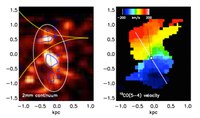The Dynamics of the First Galaxies: CO
 Swinbank et al exploit long baseline ALMA submillimeter observations of the lensed star-forming galaxy SDP 81 at z = 3.042 to investigate the properties of the interstellar medium (ISM) on scales of 50–100 pc. The kinematics of the 12CO gas within this system are well described by a rotationally supported disk with an inclination-corrected rotation speed 320 ± 20 km/s, and a dynamical mass of (3.5 ± 1.0) x 1010 M⊙ within a radius of 1.5 kpc. The disk is gas-rich and unstable and so collapse into star-forming regions with Jeans length ~ 130 pc. The authors identify five star-forming regions within the ISM on these scales and show that their scaling relations between luminosity, line widths, and sizes are significantly offset from those typical of molecular clouds in local galaxies. These offsets are likely to be caused by the high external hydrostatic pressure for the ISM, which is ~104x higher than the typical ISM pressure in the Milky Way. The physical conditions of the star-forming ISM and giant molecular clouds appear to be similar to those found in the densest environments in the local universe, such as those in the Galactic center.
Swinbank et al exploit long baseline ALMA submillimeter observations of the lensed star-forming galaxy SDP 81 at z = 3.042 to investigate the properties of the interstellar medium (ISM) on scales of 50–100 pc. The kinematics of the 12CO gas within this system are well described by a rotationally supported disk with an inclination-corrected rotation speed 320 ± 20 km/s, and a dynamical mass of (3.5 ± 1.0) x 1010 M⊙ within a radius of 1.5 kpc. The disk is gas-rich and unstable and so collapse into star-forming regions with Jeans length ~ 130 pc. The authors identify five star-forming regions within the ISM on these scales and show that their scaling relations between luminosity, line widths, and sizes are significantly offset from those typical of molecular clouds in local galaxies. These offsets are likely to be caused by the high external hydrostatic pressure for the ISM, which is ~104x higher than the typical ISM pressure in the Milky Way. The physical conditions of the star-forming ISM and giant molecular clouds appear to be similar to those found in the densest environments in the local universe, such as those in the Galactic center.
View Paper: ALMA Resolves the Properties of Star-forming Regions in a Dense Gas Disk at z ~ 3, A.M. Swinbank (Durham), S. Dye (Nottingham), J.W. Nightgale (Nottingham), C. Furlanetto (Nottingham, CAPES), Ian Smail (Durham), A. Cooray (Caltech), H. Dannerbauer (Wien), L. Dunne (Canterbury, Edinburgh), S. Eales (Cardiff), R. Gavazzi (Paris), T. Hunter (NRAO), R.J. Ivison (Edinburgh, ESO), M. Negrello (INAF), I. Oteo (Edinburgh, ESO), R. Smit (Durham), P. Van der Werf (Leiden), C. Vlahakis (JAO, ESO), 2015 ApJ Letters, 806, L17 (9 June 2015).




Connect with NRAO